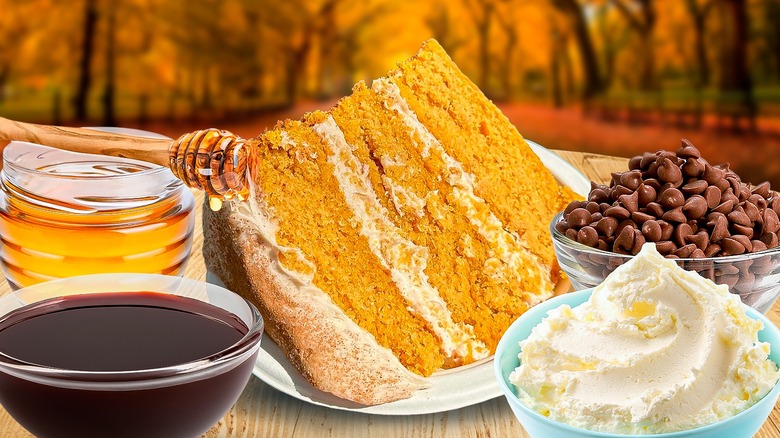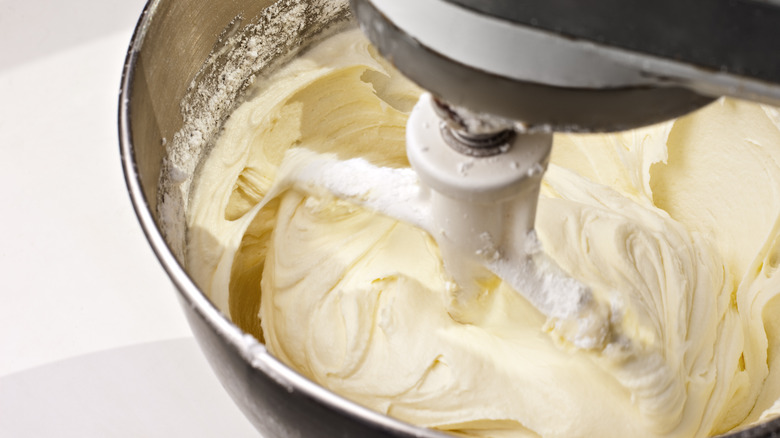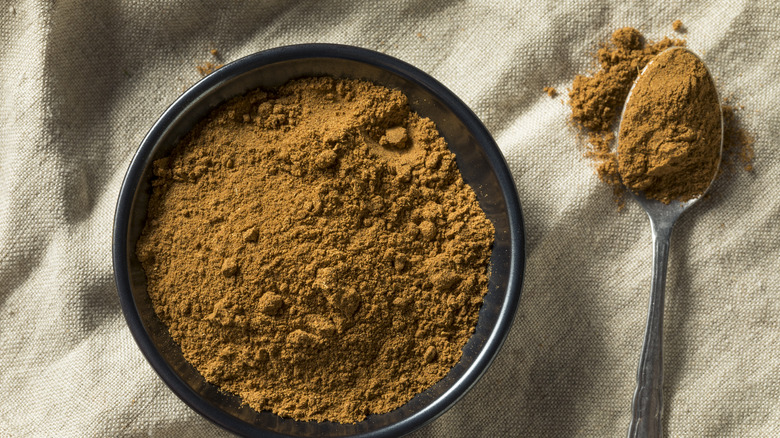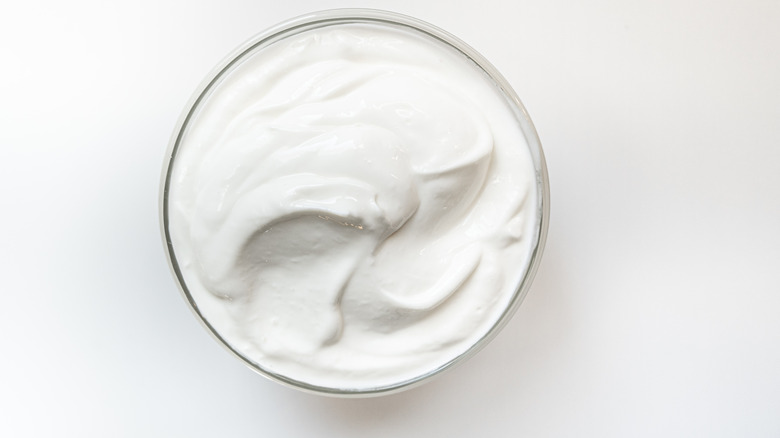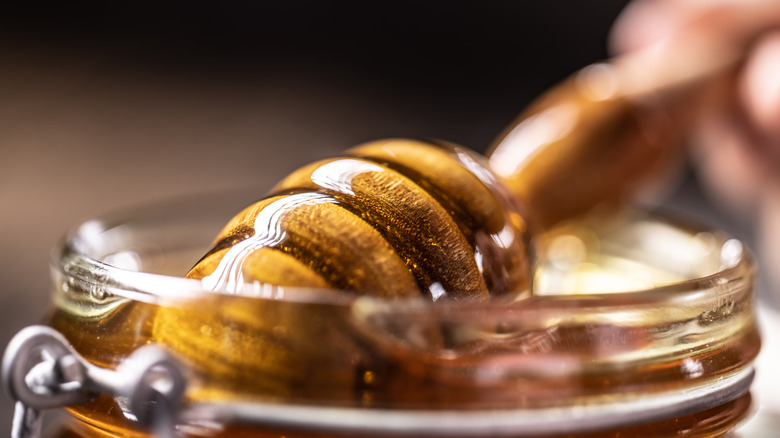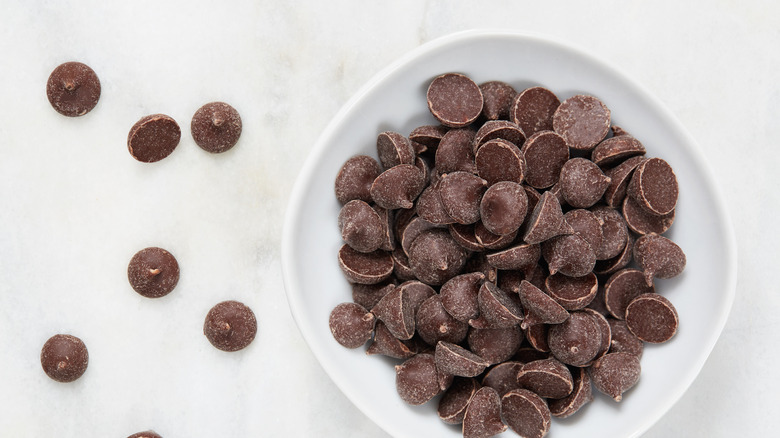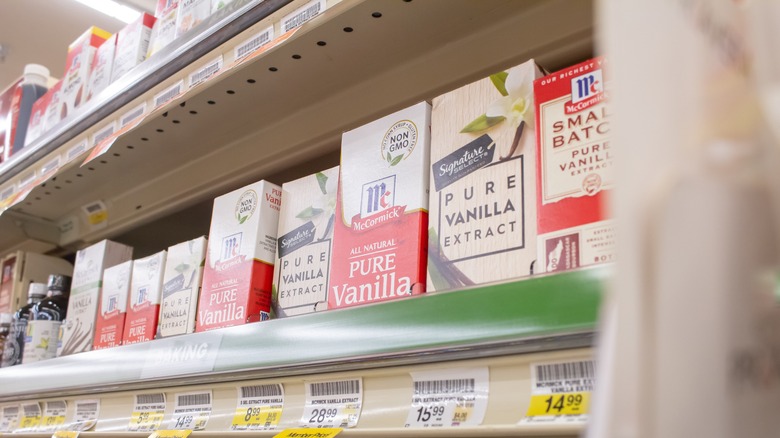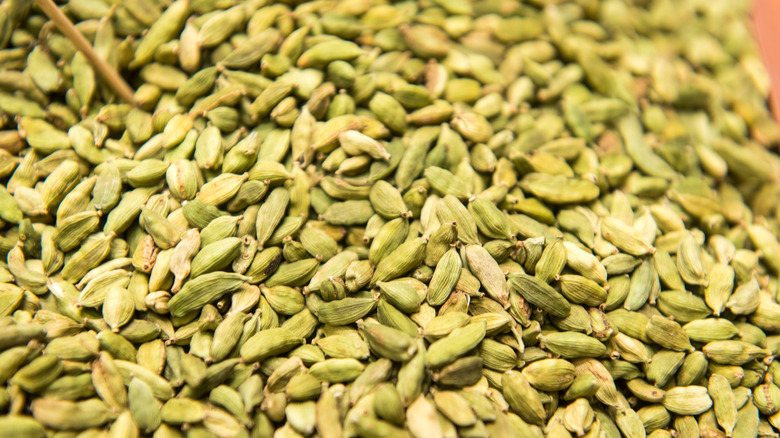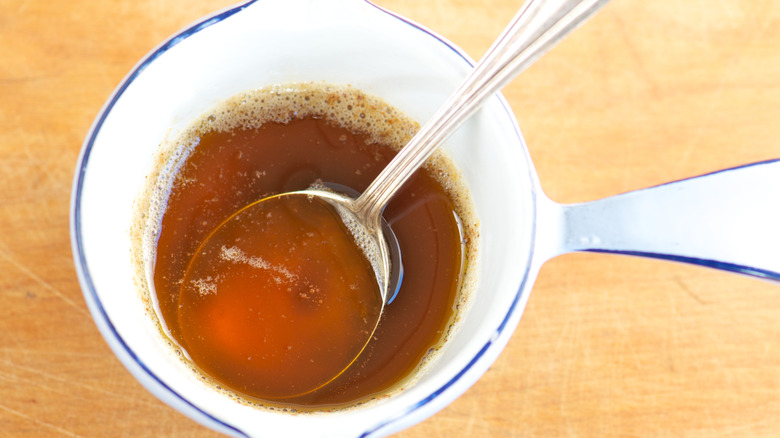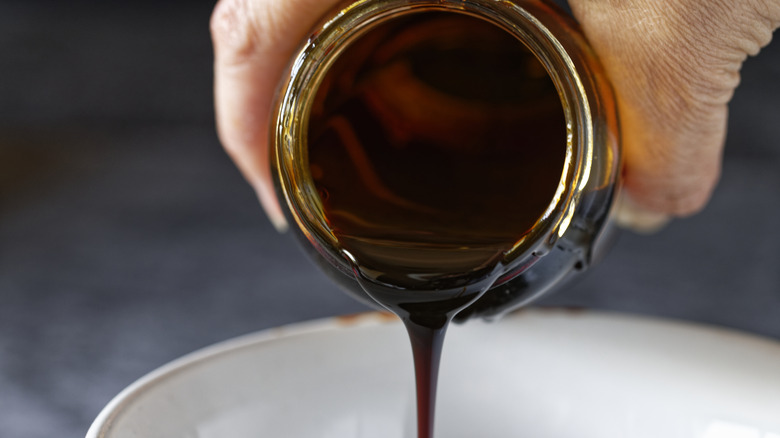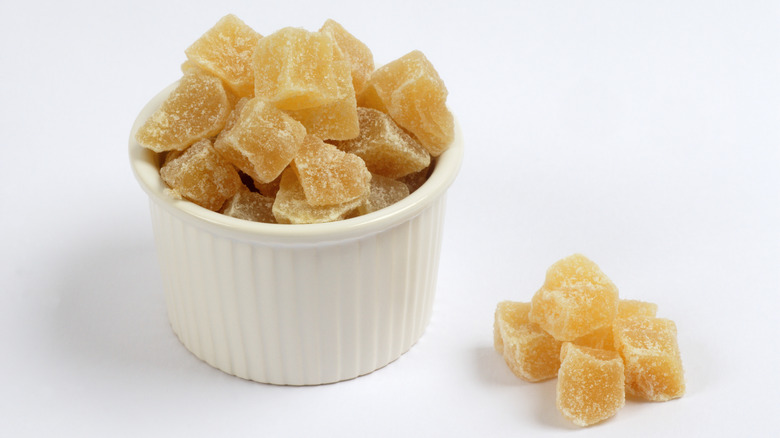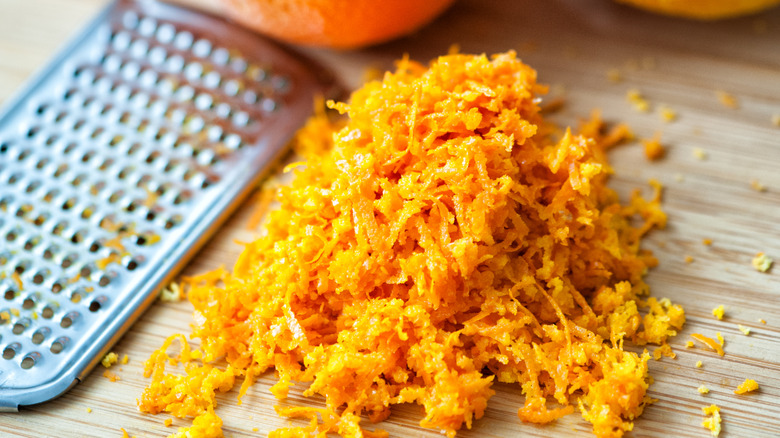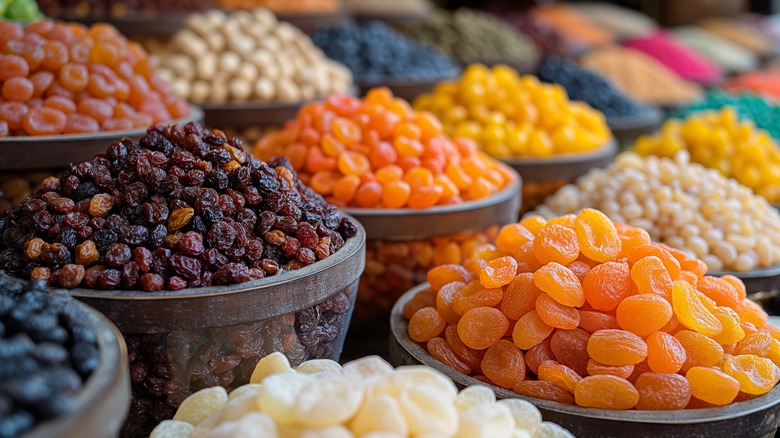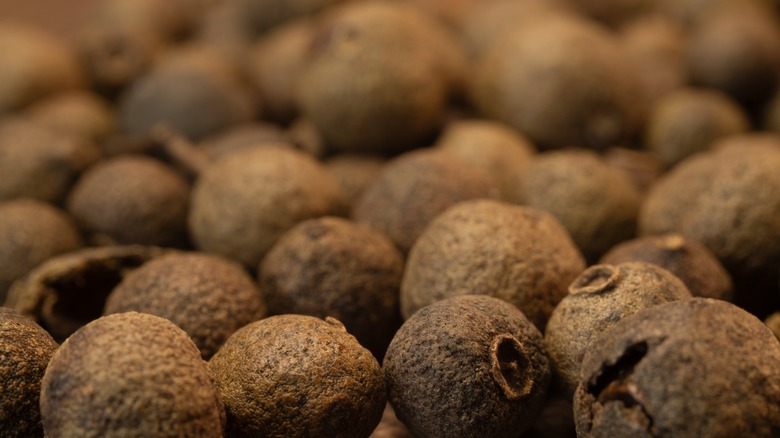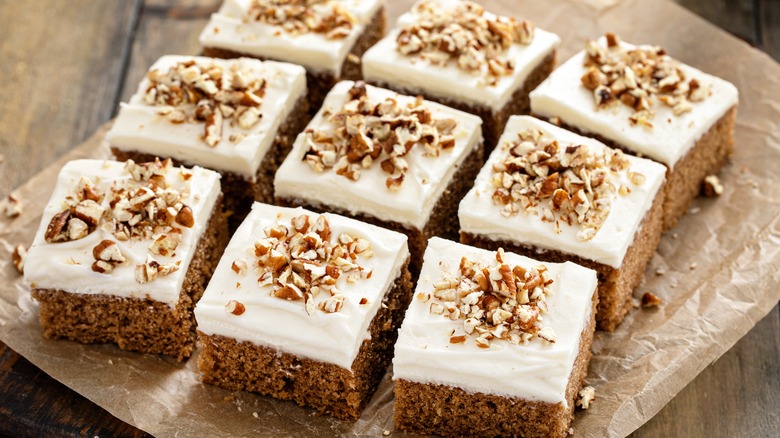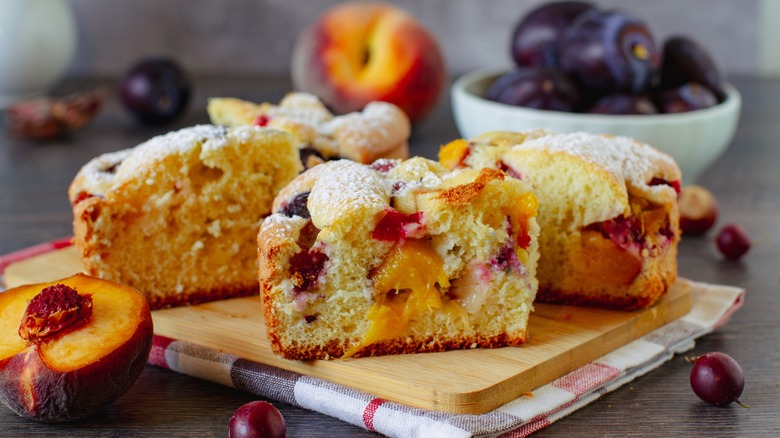16 Ingredients To Make Your Fall Spice Cake Stand Out
We may receive a commission on purchases made from links.
Spice cake is one of those desserts that warms both body and soul. It's also a great excuse to pull out those spices typically associated with autumn, including cinnamon, nutmeg, and cloves, when the weather outside is anything but warm. Besides just the flavors associated with this dessert, its texture is also worth noting. A good spice cake can be dressed up with a glaze or an icing, but it should have a soft, plush, and absolutely decadent consistency to its base.
I've come to appreciate a quality spice cake, and have also made quite a few iterations of them over the years. That being said, I'm always looking for ways to experiment with this classic recipe. These ingredients will not only complement the trinity of cinnamon, nutmeg, and cloves, but many of them can also be used to enhance the moistness of this cake or help it reach its truest, fluffiest potential. The next time you try a recipe, or experiment with a boxed spice cake mix, try adding one (or more) of these tasty additions to it.
Cream cheese
There's a reason why cream cheese and carrot cake are a tried-and-true combination. The delicate flavor of carrot cake, which has the same spices you'd find in a plain spice cake, is the perfect match for a delectably creamy and thick cream cheese frosting. So, it's not odd to think you could add cream cheese to a plain spice cake, too. Besides having a creamy mouthfeel that covers your entire mouth, cream cheese frosting also has a slightly tangy profile that really put its a step above a traditional buttercream frosting.
Like all frostings, you'll want to add your cream cheese frosting to your sponge cake after it's fully cooled so that it doesn't slosh all over the place. If you want something a little less sweet on top of your cake, or you're opting for a style of cake that doesn't typically come with a frosting layer (like a quick bread loaf), you may want to try adding a swirl of cream cheese straight to the batter itself for a fun marbling effect and toothsome mouthfeel.
Five-spice powder
Cinnamon, nutmeg, cloves, and ginger are just the start. One of my personal favorite spice blends to work with besides these spices, both for spice cake as well as for other desserts, is Chinese five-spice powder.
Five-spice powder contains some of the same spices you'd find in spice cake normally, including cinnamon and cloves, along with more atypical spices (for spice cake, at least) like anise, peppercorns, and fennel seeds. The flavor of this spice blend is somewhat difficult to describe, seeing as there are so many components, but it certainly has elements of warmth, compounded by some piquant, back-of-the-mouth heat from the peppercorns.
As with all savory-fusing-with-sweet spice blends, you should avoid being too heavy-handed with it, seeing as how strong the components like the anise and peppercorns can be. Depending on the size of your cake, you may only need to use a teaspoon of it to really feel the heat. Pair it with a slightly-sweet ginger glaze or whipped, sweet frosting to offset the warmth.
Sour cream or Greek yogurt
Sour cream isn't just an addition to your Chipotle bowl. Rather, it's also an excellent ingredient to add to spice cake. Not only does the sour cream have that bright, tangy flavor, but it also has a creamy mouthfeel that will help keep your spice cake supple. I find that the sour flavor is a great contrast to the warmth of the cinnamon, and it helps round out any overwhelmingly sweet flavors that loom over your dessert.
If you want something that gives the same effect, just with a tad extra protein, try swapping Greek yogurt for sour cream. The yogurt is thick, less tangy, and will offer extra moisture. It is also a less calorically-dense option than the sour cream. The best part is, you can add either of these fats to a homemade spice cake or one made with a boxed mix.
Honey
Sugar, either white or brown, is often the go-to when it comes to whipping up a homemade spice cake. But, that's not to say that these are the only sweeteners that you can use for your recipe. Some folks prefer the slightly floral flavor of honey in their recipe, which can round-out the spices and also add extra moisture to the cake.
There's a few important things that you need to keep in mind when working with honey, especially if you're going to be substituting it for the sugar. Besides sweetness, this ingredient will also add moisture, so you may want to adjust the amount of other liquids in your recipe slightly to account for this substitution. Since honey is acidic (though, you may have never guessed it, based on its taste), you'll also need to add about ½ teaspoon of baking soda to help the cake properly rise and to neutralize that acid. And, while honey can be used as a 1-to-1 substitute for white sugar in your recipe, it will brown much faster, so you should keep a watchful eye on your cake while it's in the oven to ensure it reaches the proper color (and no more than that).
Chocolate chips
Is chocolate ever really a bad addition to dessert? Chocolate chips will help really elevate the flavor of your spice cake because the cocoa flavor heightens the flavor of the cinnamon and cardamom. Plus, there's something oh-so-satisfying about biting into a piece of soft, fluffy, and warmly-spiced cake, only to find that there are molten chocolate morsels waiting for you.
When working with chocolate, it's important to avoid being too heavy-handed. This cake is still indeed a spice cake — not a chocolate chip loaf. The chocolate will also add more sweetness to your recipe, which, compounded with a thick, sweet frosting, could shift your dessert into the too-sweet category. Instead, I would recommend using dark or a semi-sweet chips to dial back on the sugar. You could also add a touch of cocoa powder to the dry ingredients of your cake. You don't want to make it so rich that it resembles a chocolate cake; you just want to use enough chocolate to highlight the flavor notes that make spice cake, well, spice cake.
Flavor extracts
Flavor extract are essentially shelf-stable essences. Anyone who has worked with extracts before will know that the flavor is quite potent, and depending on the type of extract you use, it can also taste artificial if you add too much.
Vanilla extract is a given when it comes to cakes, including spiced ones, but there are other extracts that you can add to jazz up your recipe. Orange extract is one that you may consider adding to your sponge; you'll need no more than a teaspoon to add extra flavor to your cake, which can be rounded out by orange juice and zest. The extract is a great complement to the warming spices and will offer some punchy and acidic flavor notes that offer reprieve from the sweetness. You can also add some nutty complexity to your cake with almond extract, or a boozy twist with a few drops of rum extract.
Alcohol
Blame it on the a-a-a-a-a-a-alcohol ... okay, now that we've relived a core 2008 memory, it's time to get back to business. Alcohol can be an excellent flavorful addition to your spice cake, provided that you select the right type. Spirts like brandy can highlight those spicy notes in the sponge, while rum will add a subtle tropical flavor to your cake (it's great paired with a coconut-infused frosting, too).
Since alcohol is a liquid, and quite flavorful, it's important to only add a little bit to your sponge for a slight pop of flavor. You don't want so much alcohol in your cake that every bite reeks and tastes like booze. There are several ways to add alcohol to a cake that doesn't overwhelm the sponge, too. For one, you can soak your dried fruit, like raisins or dried currants, in alcohol first. Or, you can add a teaspoon of rum to your glaze so that each bite will be filled with a sweet and boozy twist.
Some folks will also opt to soak the sponge in a sweet, boozy syrup instead. This will bring the taste of your alcohol of choice to the forefront, and you also won't have to mess with the chemistry of your sponge and cross your fingers in hopes that it bakes right.
Cardamom
Cardamom is one of my favorite spices to bake with because of how complex it is. Besides being a great complement to blueberries and chocolate, it's also in good company with other warming spices, like cinnamon, cloves, and allspice. You'll want to first start with ground cardamom, rather than the pods. This will allow the flavor to better distribute throughout your sponge — plus, biting into a cardamom seed isn't exactly a pleasant experience.
You have the choice of using just cardamom in your sponge, or combining it with other spices to make a well-rounded cake. If you're sticking with only cardamom, I would recommend serving it with a maple glaze or frosting to highlight the warm, peppery, and piney notes of the spice. Cardamom, despite its unique flavor profile, also plays well with others; you may want to consider making a blueberry cardamom-spiced coffee cake or toss a handful of chocolate chips into your plain cardamom-infused spice cake to give it texture and more flavor complements.
Brown butter
If there was an ingredient that I could talk about for hours, it would have to be browned butter. There are so many uses for this ingredient, including in chocolate chip cookies and in a tantalizing banana bread loaf. Therefore, it doesn't seem too odd to consider adding it to your spice cake batter to enhance its flavor.
The browning process, which can be done in the microwave or on the stovetop, is simple and will take a matter of minutes. When it's all said and done, you'll be left with golden-colored liquid that's brimming with the flavors of toffee and hazelnuts. The brown butter's profile is an excellent pairing with the warming spices in the cake, and the fat content will ensure that your cake stays soft and supple.
You'll want to let the brown butter solidify for a little bit before adding it to your cake batter. Depending on the recipe, I would still recommend supplementing it with some vegetable oil to ensure that your cake bakes properly and has that divine, plush texture. You could also integrate brown butter into the frosting; just be sure it's in a soft (yet solid) state before you add it to your stand mixer.
Molasses
Rich, dense, and stick-to-your-ribs — yep, I'm talking about molasses (although the descriptor would also work for mac and cheese, too). Molasses is a byproduct of sugar making and comes in three varieties: light, dark, and blackstrap. While the flavor will vary depending on the type that you select, overall, molasses has sweet undertones that intercept bitterness; you'll also detect some prune-y and burnt caramel notes.
Although the flavor of molasses might be astringent to some, when combined with other ingredients in a spice cake, it can offer a subtly sweet flavor and tons of moisture. You should use either light or dark molasses for your cake, as blackstrap molasses may overpower the subtle spices. You may also want to thin out the molasses with warm water before stirring it into the wet ingredients; this will make it a bit easier to mix. This gingerbread-spice-cake hybrid is the perfect recipe for a cool fall morning or for serving as a dessert during the holidays.
Candied ginger
Candied ginger is not an ingredient that many folks have laying around in their kitchens. While many people recognize ginger as being an ingredient that's subtly spicy and packs a little bit of heat, candied ginger replaces some of that fiery flavor with sweetness. Crystallized ginger, which is candied ginger with covered in a crunchy sugar coating, has a more complex texture and may be a better fit for your recipe than the plain candied variety. Although there are many retailers that sell both products, you could also try your hand at making homemade candied (or crystallized) ginger with three simple ingredients: ginger root, water, and sugar.
Candied ginger makes an excellent accompaniment to your spice cake because the sweet, and slightly-spicy flavors in the ginger complement the seasonings already present in the cake, including dried ginger. It's important to note that the texture of candied ginger isn't everyone's cup of tea (or may I say, slice of cake) because it's dense and chewy, like a Sour Patch Kids candy. Instead of adding it to the sponge, I would recommend finely chopping the candied ginger and using it as a garnish.
Citrus zest
Citrus zest is an excellent accompaniment to your spice cake recipe because it introduces the flavorful oils from the fruit to your recipe, as well as a pop of color. Fruits like orange and lemon have the capability to lighten your dessert significantly, and all you need to do is grate a little bit of zest directly into the sponge to harness this potential.
Orange is in good company with cinnamon, cardamom, and nutmeg and would be my choice over lemon, which has a more acidic and less complex profile Oranges have a robust flavor that can really offer something novel and intriguing, rather than something purely tart. Like other flavor enhancers on this list, there are several ways to add citrus zest to your spice cake. You could grate it into the batter; just be sure to avoid taking too much of the pith off, otherwise you'll make your batter bitter. I personally prefer zested citrus in the frosting of the cake or as a garnish, though, since you won't have to worry about the heat masking any of that bright, citrusy essence.
Dried fruits
You may not be a person who can tolerate the texture of dried fruits in your baked goods. So if you gag at the thought of an oatmeal raisin cookie, this might not be best ingredient for you. But, if you can tolerate a toothsome bite and a little squishiness, you may want to try adding dried fruit to your spice cake recipe.
Raisins, dried cranberries, and prunes are all fair-game when it comes to spice cake. These fruits will lend sweetness to your cake and offer some textural variety. There are two ways to go about adding the fruits to your batter. First off, you could stir the fruits in directly from the container. Or, if you want to give your spice cake a fresher texture, you may want to try soaking the dried fruit in water first (or some other liquid), then stirring it in to your recipe. Besides offering a milder mouthfeel, soaking the fruits ahead of time will prevent them from drawing too much moisture from the cake batter as the sponge bakes.
Allspice
Allspice may or may not be a spice that your recipe calls for. But, if you're on the fence about adding it into your batter, this is your sign to add at least a little sprinkle.
Allspice berries take on a broad swath of flavor profiles, including those of cinnamon, cloves, and nutmeg. Though, it isn't a spice blend (as its name might suggest); it's the berry derived from the allspice plant. This ground berry could theoretically be used as a replacement for its three primary flavors, but I think it's equally as excellent when it's added to the batter in addition to those spices.
You may only need less than a teaspoon of allspice to bring an extra dose of warmth to your spice cake. I find that baking subdues some of its piquant and peppery notes, so I would recommend baking it into the sponge, rather than adding it to the icing or as a garnish, for the most approachable flavor.
Nuts
Nuts are a great way to add texture to your spice cake, and the best part is, there are so many different ones to choose from. Almonds? Pistachios? Walnuts? There's simply no wrong answer.
If you want to add the nuts to your sponge, you'll need to ensure that they're chopped up into super small pieces. I personally prefer using walnuts or pecans for my spice cake recipe, as they are soft enough to impart a crunch, but they aren't too tooth-shatteringly crisp that they distract from the cake surrounding them. Or, you could add the nuts to the top of your cake as a garnish. For an extra special touch, consider candying your nuts. Candied pecans, for example, would be an excellent pairing for a sweet cinnamon and nutmeg-infused sponge.
Fresh fruits
If dried fruits aren't your idea of a fun time, maybe fresh fruit is. Fresh fruit (and some vegetables, too) can add extra moisture to your sponge and prevent it from drying out too quickly.
When it comes to selecting fruits for the cake, I tend to go for ones that mesh well with autumnal spices. You may consider adding some chopped apples (or even canned apple pie filling) to your cake for moisture and a soft, sweet flavor. If you want an ingredient that's a little less flavor-dominant, but still brings that burst of moisture, consider some grated zucchini or carrots. Canned pumpkin puree can also make your spice cake a bit more decadent, but you'll risk turning your spice cake into pumpkin bread (though, I certainly wouldn't complain). Regardless of what fruit you select, be sure to chop it into small pieces and stir it into your spice cake batter so it's well-distributed.
